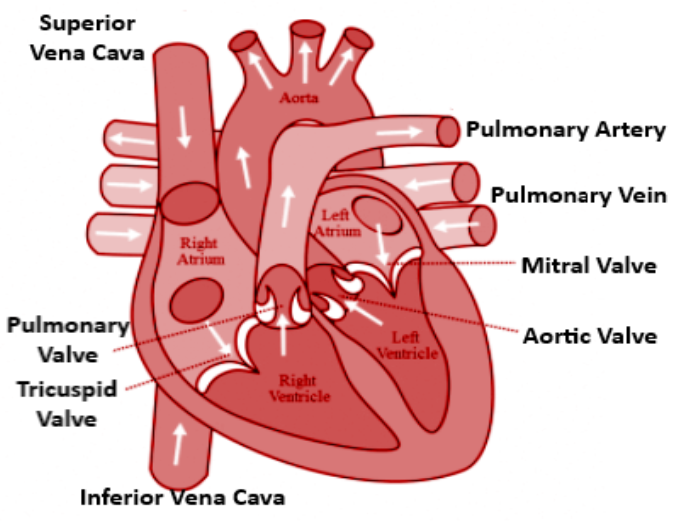
Describe the flow of blood through the heart of human beings.
Answer
460.8k+ views
Hint: The heart is a primarily hollow, muscular organ composed of cardiac muscles and connective tissue that works as a pump for the circulation of blood around the tissues of the body. The heart has a dual pump function which carries blood away from and returning to it.
Complete answer: Initially, blood reaches the heart from two large veins, the inferior and also the superior vena cava, flushing oxygen-poor blood from the body to the right atrium. The pulmonary vein expels oxygen-rich blood from the lungs to the left atrium. Blood goes via the open tricuspid from the right atrium to the right ventricle. The heart valves shut whenever the ventricles are finished. This inhibits the backflow of blood into the atria as the ventricles contract (squeeze). Blood passes through the open valve from the left atrium to the left ventricle. Whenever the ventricles are full, the mitral valve closes down. This prohibits the backflow of blood into the atria as the ventricles contract (squeeze). Oxygen and carbon dioxide molecules migrate into and out of tiny airbags in the lungs, through capillary walls, via the blood. Blood exits the heart through the pulmonary valve. Blood exits the heart through an aortic valve, through the aorta, and then through the body. This sequence is repeated, which enables blood to be pumped continuously to the heart, lungs, and body.

Additional information:
When the heart is beating, it pumps the blood into the blood vessels system known as the circulatory system. Vessels are elastic lines that supply blood to any body part. In fact, if the heart stops, the brain cells die in about 4-6 minutes with no blood supply, and then after 10 minutes of no blood circulation, the brain cells will stop functioning and will also be deceased completely.
Note: Once the blood flows through the pulmonary valve, it hits the lungs. This is called the pulmonary circulation. Blood rushes from the pulmonary valve to the pulmonary artery to delicate capillaries in the lungs. Oxygen flows from tiny airbags in the lungs, through the capillary walls, to the blood. At almost the same time, carbon dioxide, a waste material of digestion, travels from the blood to the airbags. Carbon dioxide exits the body as we exhale. Once all the blood is filtered and oxygenated, it passes it back through the pulmonary veins to the left atrium.
Complete answer: Initially, blood reaches the heart from two large veins, the inferior and also the superior vena cava, flushing oxygen-poor blood from the body to the right atrium. The pulmonary vein expels oxygen-rich blood from the lungs to the left atrium. Blood goes via the open tricuspid from the right atrium to the right ventricle. The heart valves shut whenever the ventricles are finished. This inhibits the backflow of blood into the atria as the ventricles contract (squeeze). Blood passes through the open valve from the left atrium to the left ventricle. Whenever the ventricles are full, the mitral valve closes down. This prohibits the backflow of blood into the atria as the ventricles contract (squeeze). Oxygen and carbon dioxide molecules migrate into and out of tiny airbags in the lungs, through capillary walls, via the blood. Blood exits the heart through the pulmonary valve. Blood exits the heart through an aortic valve, through the aorta, and then through the body. This sequence is repeated, which enables blood to be pumped continuously to the heart, lungs, and body.

Additional information:
When the heart is beating, it pumps the blood into the blood vessels system known as the circulatory system. Vessels are elastic lines that supply blood to any body part. In fact, if the heart stops, the brain cells die in about 4-6 minutes with no blood supply, and then after 10 minutes of no blood circulation, the brain cells will stop functioning and will also be deceased completely.
Note: Once the blood flows through the pulmonary valve, it hits the lungs. This is called the pulmonary circulation. Blood rushes from the pulmonary valve to the pulmonary artery to delicate capillaries in the lungs. Oxygen flows from tiny airbags in the lungs, through the capillary walls, to the blood. At almost the same time, carbon dioxide, a waste material of digestion, travels from the blood to the airbags. Carbon dioxide exits the body as we exhale. Once all the blood is filtered and oxygenated, it passes it back through the pulmonary veins to the left atrium.
Recently Updated Pages
What percentage of the area in India is covered by class 10 social science CBSE

The area of a 6m wide road outside a garden in all class 10 maths CBSE

What is the electric flux through a cube of side 1 class 10 physics CBSE

If one root of x2 x k 0 maybe the square of the other class 10 maths CBSE

The radius and height of a cylinder are in the ratio class 10 maths CBSE

An almirah is sold for 5400 Rs after allowing a discount class 10 maths CBSE

Trending doubts
For Frost what do fire and ice stand for Here are some class 10 english CBSE

What did the military generals do How did their attitude class 10 english CBSE

The Equation xxx + 2 is Satisfied when x is Equal to Class 10 Maths

What did being free mean to Mandela as a boy and as class 10 english CBSE

Why is there a time difference of about 5 hours between class 10 social science CBSE

What did Valli find about the bus journey How did she class 10 english CBSE




